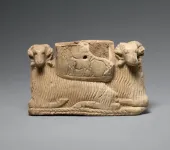(Press-News.org) PITTSBURGH, Jan. 30, 2025 – A prophylactic antibody-based immune therapy protects monkeys against severe disease caused by H5N1 avian flu, University of Pittsburgh and NIH Vaccine Research Center researchers report today in Science.
The broadly neutralizing antibody, which recognizes a relatively stable region of the bird flu virus, is less prone to losing its efficacy than antibodies targeting influenza’s more mutation-prone structures. This feature ensures that the immune protection can withstand the possible emergence of virus variants, akin to the SARS-CoV-2 mutants that evolved during the COVID-19 pandemic, and provide lasting protection against a globally spreading airborne infection.
“This type of prevention can be very useful in controlling infection outbreaks and containing the bird flu pandemic,” said co-corresponding author Douglas Reed, Ph.D., associate professor of immunology at Pitt’s School of Medicine and the Center for Vaccine Research. “In our testing, the antibody performed beautifully. The antibody could be useful as a prophylactic of severe disease in vulnerable populations, and it also helped us establish the testing threshold for antibody levels in blood, which would be useful for judging the immune protection generated by a universal flu vaccine.”
While, as of January 2025, only one reported case of H5N1 infection in the U.S has resulted in death, the World Health Organization has reported over 950 cases globally since 1997, with more than half of them fatal. And the concern for wider spread continues to grow. In addition to spreading among cattle in the U.S., H5N1 has spread from wild birds to mammals around the world, including sea lions in South America and mink in Europe. Genetic analysis of two human samples from North America suggested that the virus is adapting and getting better at causing disease and spreading in mammals.
Pitt researchers have long been concerned about the possible spread of avian flu from animals to humans, and have been developing and testing prophylactic interventions – vaccines and protective antibodies -- in animal models closely resembling humans. In a study published in iScience in 2023, the group reported on further refinements of their aerosol monkey model that closely mimics the symptoms of severe infection with H5N1 in humans, including acute respiratory distress syndrome – a life-threatening lung injury that can occur upon exposure to bird flu.
One special concern about developing a prophylactic against influenza infections lies in the virus’s propensity to quickly adapt to new conditions and environments, the researchers note. Because seasonal flu viruses change and avoid immune responses built up in prior years, an effective seasonal flu vaccine must be reformulated yearly to match the dominant strain. Antibodies targeting the hemagglutinin stalk region that is preserved across different influenza isolates, such as the strain of H5N1 tested in the new study, circumvents the abovementioned challenge and provides broadly neutralizing protection.
“This antibody is targeting a region that does not vary across different influenza viruses,” said co-corresponding author Simon Barratt-Boyes, Ph.D., professor of infectious diseases and microbiology at Pitt’s School of Public Health and immunology at Pitt’s School of Medicine. “Think about it as a tree – different species have different leaves and crowns, but tree trunks look very much the same. Similarly, the stalk region of the bird flu virus closely resembles the same structure of seasonal influenza, which makes it possible for stalk-targeting antibodies to provide universal protection.”
In a new study, monkeys pre-treated with a moderate dose of a broadly neutralizing MEDI8852 antibody were universally protected against severe disease and death. In addition to confirming the antibody’s efficacy in preventing serious adverse health outcomes, scientists were also able to establish its minimum serum concentration required for protection – a measurement useful for establishing the protective threshold of a potential universal flu vaccine.
The research sets the stage for the development of medical countermeasures against future influenza virus pandemics. Serum levels of MEDI8852 sufficient for protection remained stable for 8 to 12 weeks, suggesting that, if given early, it could protect first responders and others caring for patients at the beginning of an outbreak of H5N1.
Masaru Kanekiyo, Ph.D., of the NIH Vaccine Research Center, also contributed to the study. Other authors of this research are affiliated with the NIH Vaccine Research Center, Pitt, UPMC, University of Georgia and AstraZeneca.
END
Antibody treatment prevents severe bird flu in monkeys
2025-01-30
ELSE PRESS RELEASES FROM THIS DATE:
Polar bear energetic model reveals drivers of polar bear population decline
2025-01-30
Polar bears in Western Hudson Bay have seen their population nearly halved over the last several decades, largely due to dwindling sea ice and limited hunting opportunities, according to the findings of a novel bioenergetic model using data spanning more than 40 years. The findings reveal the relationship between bears’ individual energy needs and environmental limitations in driving population trends, highlighting energy as the central limiting factor behind the decline of a key Arctic apex predator. The Arctic is warming ...
Socioeconomic and political stability bolstered wild tiger recovery in India
2025-01-30
India, the world’s most populated country, has been successfully working to recover one of the largest, and most iconic, carnivores, the tiger, for decades. Protection, prey, peace, and prosperity have been key factors in the tiger recovery within this densely populated country, according to a new study. According to its authors, success in India offers a rare opportunity to explore the socio-ecological factors influencing tiger recovery more broadly. Earth’s large carnivores, crucial for maintaining ecosystem health, are among the most threatened species, impacted ...
Scratching an itch promotes antibacterial inflammation
2025-01-30
New research uncovers the dual nature of scratching an itch; although it can worsen skin inflammation, it can also boost immune defenses against bacterial infections at the injury site. The findings shed light on a pharmacologically targetable pathway that explains how scratching triggers inflammation, resolving the paradox of scratching as both a harmful pathological process and a beneficial evolutionary adaptation. Scratching is a natural, instinctive response to the sensation of itching, and it plays a central role in many ...
Drivers, causes and impacts of the 2023 Sikkim flood in India
2025-01-30
In a comprehensive analysis, researchers present the divers, causes, and impacts of the catastrophic 2023 Sikkim glacial lake outburst flood (GLOF). The findings stress the urgent need to enhance GLOF hazard assessments and improve prediction and early warning systems as melting glaciers steadily raise the risk of GLOFs in the Himalayan region. South Lhonak Lake – perched at 5200 meters above sea level in the Upper Teesta basin of Sikkim, India – is among the region's largest and most rapidly expanding glacial lakes, posing severe hazards due to its ...
Most engineered human cells created for studying disease
2025-01-30
The most complex engineering of human cell lines ever has been achieved by scientists, revealing that our genomes are more resilient to significant structural changes than was previously thought.
Researchers from the Wellcome Sanger Institute, Imperial College London, Harvard University in the US and their collaborators used CRISPR prime editing to create multiple versions of human genomes in cell lines, each with different structural changes. Using genome sequencing, they were able to analyse the genetic effects of these structural variations on cell survival.
The research, published today (30 January) in Science, ...
Polar bear population decline the direct result of extended ‘energy deficit’ due to lack of food
2025-01-30
U of T Scarborough researchers have directly linked population decline in polar bears living in Western Hudson Bay to shrinking sea ice caused by climate change.
The researchers developed a model that finds population decline is the result of the bears not getting enough energy, and that’s due to a lack of food caused by shorter hunting seasons on dwindling sea ice.
“A loss of sea ice means bears spend less time hunting seals and more time fasting on land,” says Louise Archer, a U of T Scarborough postdoc and lead author of the study.
“This negatively affects the bears’ energy ...
Lifecycle Journal launches: A new vision for scholarly publishing
2025-01-30
(Charlottesville, VA, Jan. 30, 2025) – The Center for Open Science (COS) is excited to announce that Lifecycle Journal, a 3-year research and development pilot on a new model of scholarly communication, is now open for submissions. Lifecycle Journal reimagines scholarly publishing in line with scholarly values of rigor, transparency, sharing, correction, and community evaluation. Lifecycle Journal offers a dynamic, community-driven approach to scholarly publishing, providing a new experience for authors, reviewers, and readers to critically engage with research throughout the entire research lifecycle.
The traditional ...
Ancient DNA analyses bring to life the 11,000-year intertwined genomic history of sheep and humans
2025-01-30
Sheep have been intertwined with human livelihoods for over 11,000 years. As well as meat, their domestication led to humans being nourished by their protein-rich milk and clothed by warm, water-resistant fabrics made from their wool.
Now, an international and interdisciplinary team of researchers led by geneticists from Trinity College Dublin and zooarchaeologists from LMU Munich and the Bavarian State Collections of Natural History (SNSB) has deciphered the prehistoric cultural trajectory of this species by analysing 118 genomes recovered from archaeological bones dating across 12 millennia and stretching from Mongolia to ...
Climate change increases risk of successive natural hazards in the Himalayas
2025-01-30
An international study has investigated the causes and impacts of the devastating flood disaster in the Himalayas in October 2023, which destroyed large areas along and surrounding the Teesta River in Sikkim, India. A research team from nine countries, including researchers from the University of Zurich (UZH), analyzed the complex drivers, causes and consequences of this flood cascade and reconstructed the exact time of its onset.
Massive damage caused by tsunami wave
On 3 October 2023, approximately 14.7 million cubic meters of frozen ...
From bowling balls to hip joints: Chemists create recyclable alternative to durable plastics
2025-01-30
ITHACA, N.Y. – Cornell University researchers have developed a recyclable alternative to a durable class of plastics used for items like car tires, replacement hip joints and bowling balls.
Known as thermosets, this type of plastic boasts a “crosslinked polymer” chemical structure that guarantees longevity but has also made these petrochemical-based materials – which comprise 15%-20% of all polymers produced – impossible to recycle.
“Currently, zero percent of the world’s thermoset materials are recycled – they’re either incinerated ...



